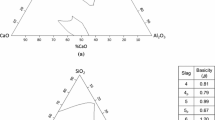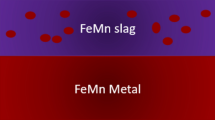Abstract
Interfacial phenomena between hot metal, liquid slag and solid CaO are important to the understanding of the desulfurization reaction in hot-metal treatment processes. In the current work, the surface tension of molten iron-carbon alloy and liquid slag as well as the interfacial tensions among molten iron-carbon alloy-solid CaO, liquid slag-solid CaO, as well as molten iron-carbon alloy-liquid slag were measured in the temperature range 1623 K to 1723 K (1350 °C to 1450 °C). The sessile drop method has been used for these measurements. To analyze the experimental results, two types of graphical analysis programs have been developed to determine the coordinates of the X-ray shadow or charge-coupled device (CCD) image of the droplet. Furthermore, a software package that uses the Gauss-Newton method to minimize an error function between the physically observed and a theoretical Laplacian curve has also been developed in this work.















Similar content being viewed by others
References
T. Takaoka, Y. Kikuchi, and K. Yamada: CAMP-ISIJ, 1998, vol. 11, p. 765.
Y. Kawai, T. Takaoka, Y. Kikuchi, and K. Yamada: CAMP-ISIJ, 1999, vol. 12, p. 132.
The Iron and Steel Institute of Japan, Physical and Chemical Data Book for Iron- and Steelmaking, Ironmaking, The Iron and Steel Institute of Japan, Tokyo, Japan, 2006.
Slag Atlas, 2nd ed., VDEh, Verlag Stahleisen GmbH, ed., Düsseldorf, Germany, 1995.
T.B. Massalski, ed.: Binary Alloy Phase Diagrams, vol. 1, ASM, Materials Park, OH, 1986.
I. Jimbo and A.W. Cramb: ISIJ Int., 1992, vol. 32, pp. 26–35.
T. Tanaka: Bull. Iron Steel Inst. Jpn., 2003, vol. 8, no. 3, pp. 161–66.
A.S. Krylov, A.V. Vvedensky, A.M. Katsnelson, and A.E. Tugovikov: J. Non-Cryst. Solid, 1993, vols. 156–158, pp. 845–48.
I. Jimbo and A.W. Cramb: Metall. Trans. B, 1993, vol. 24B, pp. 5–10.
T. Young: Miscellaneous Works, vol. 1, G. Peacock and J. Murray, eds., Dover Publications, London, U.K., 1805.
D.T. Livey and P. Murray: J. Am. Ceram. Soc., 1956, vol. 39, pp. 363–72.
Japan Society for Promotion of Science: Steelmaking Data Sourcebook, Gordon and Breach Science Publishers, New York, NY, 1988.
J. Lee and K. Morita: ISIJ Int., 2004, vol. 44, pp. 235–42.
J. Lee and K. Morita: Steel Res., 2002, vol. 73, pp. 367–72.
I. Jimbo, A. Shara, and A.W. Cramb: Trans. ISS, 1995, vol. 16, pp. 45–52.
K. Nakajima: Tetsu-to-Hagané, 1994, vol. 80, pp. 593–98.
R.E. Boni and D. Derge: Trans. AIME, 1956, vol. 206, pp. 59–64.
M. Zielinski and B. Sikora: Prace IMZ, 1977, vol. 29, nos. 3–4, pp. 157–65.
B. Sikora and M. Zielinski: Huntnick., 1974, vol. 41 (9), p. 433.
G.S. Esshov and E.A. Popova: Russ. J. Inorg. Chem., 1964, vol. 9 (3), p. 361.
K. Ogino, S. Hara, and E. Shibahara: Tetsu-to-Hagané, 1972, vol. 58, p. S388.
A. Nishiwaki and K. Ogino: Tetsu-to-Hagané, 1985, vol. 71, p. S121.
A. Adachi, K. Ogino, and T. Suetaki: Tetsu-to-Hagané, 1964, vol. 50, pp. 1838–41.
B. van Muu, H.W. Fenzke, and H.J. Eckstein: Neue Hütte, 1985, vol. 30, p. 341.
J.L. Bretonnet, L.D. Lucas, and M. Olette: C.R. Acad. Sci. Paris, 1977, vol. 285, p. 45.
K. Mukai: Kouon-yutai-no-kaimen-butsuri-kagaku, Agne Gijutsu Center, Tokyo, Japan, 2007.
Y. Hino, Y. Nakai, I. Sumi, S. Nabeshima, and Y. Kishimoto: CAMP-ISIJ, 2007, vol. 20, p. 89.
Y. Taniguchi, N. Sano, and S. Seetharaman: ISIJ Int., 2009, vol. 49, pp. 156–63.
F. Bashforth and J.C. Adams: An Attempt of Test the Theories of Capillary Action, Cambridge University Press, Cambridge, U.K., 1883.
Y. Rotenberg, L. Boruvka, and A.W. Neumann: J. Colloid Inter. Sci., 1983, vol. 93, pp. 169–83.
Acknowledgments
The authors express their sincere gratitude to Dr. Taishi Matsushita and Dr. Lidong Teng of the Division of Materials Process Science, Royal Institute of Technology for their support and valuable discussions. The author also is grateful to Professor L. Holappa, Dr. E. Heikinheimo (Laboratory of Metallurgy, Helsinki University of Technology), and Dr. M. Nakamoto (formerly with the Laboratory of Metallurgy, Helsinki University of Technology is now with the Laboratory of Materials and Metallurgy Renaissance in Innovative Iron & Steel Technology, Graduate School of Engineering, Osaka University, Osaka, Japan) for their help in the dynamic wettability measurement and discussions in the surface tension calculation.
Author information
Authors and Affiliations
Corresponding author
Additional information
Manuscript submitted November 9, 2011.
Appendix. Surface tension and contact angle calculation
Appendix. Surface tension and contact angle calculation
Theory and Calculation Method
Suppose that a total of N data points was selected from the observed droplet contour. An error function between the physically observed and a theoretical Laplacian curve is defined as follows:
where ox n and oz n are the x and z coordinates of observed n th point, and x n and z n are those of the nearest point on the theoretical curve from the observed point. The values of x n and z n can be calculated by using Eqs. [2] to [6]. Thus, the error function E is given by the following four variables:
Hence, Eq. [A1] is rewritten as
If the variables are increased Δq 1, Δq 2, Δq 3, and Δq 4, respectively, then Eq. [A3] is expressed as
The conditions of an extremum in the value of the error function are given by
Δq 1, Δq 2, Δq 3, and Δq 4 are computed by solving Eq. [A5]. Then the new variables
are substituted into Eq. [A4], and Eq. [A5] is repeated until the value of error function E becomes sufficiently small.
Finally, the surface tension is given by
The contact angle θ is calculated by using Eq. [2] through [4] with the following values and given by:
where q final k (k = 1, 2, 3, 4) are the values of q k under the convergent condition.
The volume of the droplet can be calculated by using Eqs. [A10][29] and [A11]
where x is the radius of the droplet on the substrate.
Actual Calculation Procedure
To obtain the accurate calculation results of the surface tension and the contact angle, it is important to give the initial values of variables that are sufficiently close to the optimum values. Otherwise, if poor initial values are given, the convergent calculation might diverge. Appealing attempts that eliminate this disadvantage of the Gauss-Newton method are the introduction of graphic visualization of the initial condition and user-definable initial values.
When the data of observed coordinates are loaded, the program automatically starts calculation of the droplet contour by using Eqs. [2] through [4] with the following start values:
-
h = q 1 = maximum value of the z coordinate of observed points
\( \frac{2}{b} = q_{2} \) = fixed value
\( \frac{\rho g}{\gamma } = q_{3} \) = 0 (γ = infinity)
x 0 = q 4 = defined in the data file
Then the x-way distance between the observed point that has minimum value of z coordinate and the calculated contour are computed. If the distance is larger than the threshold value, q 2 = q 2 + dq 2 is substituted into Eq. [4] and the calculation is repeated until the distance is smaller than the threshold value. The results are shown graphically. In case that the given initial values are not good, the user can change the values of q 1, q 3, and q 4 manually and reevaluate the initial value of q 2. These procedures are shown in Figures A1 and A2. Figure A1 shows a graphic of the initial condition estimated by the program. In the figure, the squares express the observed points on the right side of the defined droplet center (x = x 0). The circles in the figure express those on the left side of the droplet center, and they are rotated 180 deg with respect to x = x 0. Because the droplet profile has symmetry with respect to the actual droplet center, Figure A1 indicates that the quality of the observed points or the defined x 0 value is not appropriate. In this case, the value of x 0 is intentionally changed for explanation. Figure A2 shows a graphic after a user modification.
Two more attempts to eliminate the disadvantage of the Gauss-Newton method are applied to the convergent calculation. In the convergent calculation, Eq. [A7] is modified as follows:
where α is a damping factor,[30] 0 < α ≤ 1. Furthermore, once the convergent condition is obtained, the program will start recalculation automatically using q final k (k = 1, 2, 3, 4) as the initial values. It will be repeated until the value of \( \left( {q_{3}^{\text{final}} } \right)_{{\left( {j + 1} \right)^{\text{th}} }} - \left( {q_{3}^{\text{final}} } \right)_{{j^{\text{th}} }} \) becomes smaller than the threshold value. Here, \( \left( {q_{3}^{\text{final}} } \right)_{{j^{\text{th}} }} \) is the value of q 3 under the j th convergent condition. Therefore, the program estimated initial values can be used in most cases. The results are also shown graphically. Thus, the reliability of the computation results can be estimated. The actual program window is shown in Figure 5.
Rights and permissions
About this article
Cite this article
Taniguchi, Y., Seetharaman, S. Interfacial Phenomena among Liquid Iron-Carbon Alloy, Liquid Slag, and Solid CaO. Metall Mater Trans B 43, 587–597 (2012). https://doi.org/10.1007/s11663-012-9639-1
Published:
Issue Date:
DOI: https://doi.org/10.1007/s11663-012-9639-1






